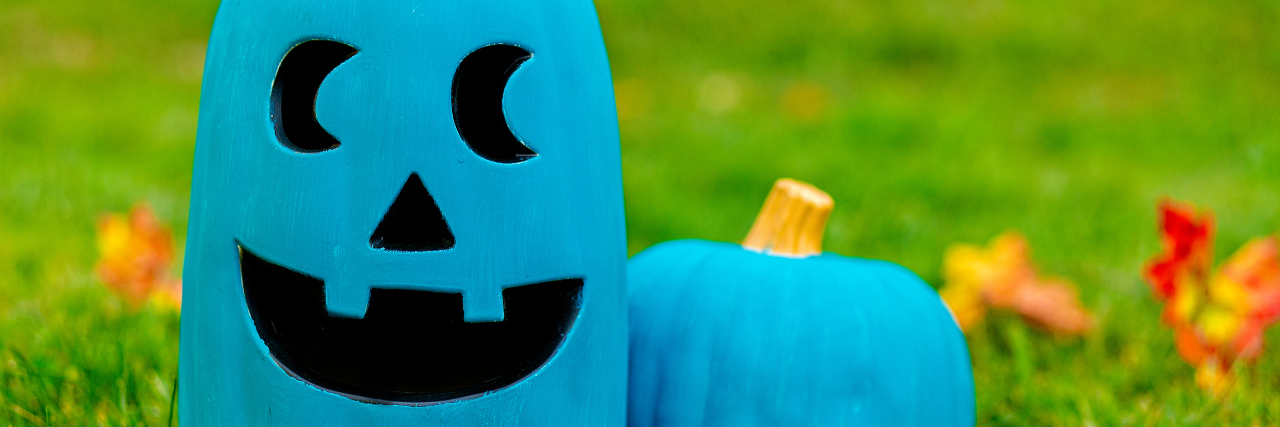Perhaps as you stroll by the Halloween section of stores, you’ve noticed a selection of teal pumpkins. While the color might have grabbed your eye, the reason for the teal pumpkins goes beyond a new color scheme to celebrate Halloween.
By placing a teal pumpkin on your doorstep, you let trick-or-treaters know you have non-food treats available, such as glow sticks or small toys.
This simple act promotes inclusion for trick-or-treaters with food allergies or other medical or chronic conditions.
“My daughter has oral aversion and is literally afraid to put food in her mouth. It’s nice to have options like the teal pumpkin project to make trick or treating fun for her too.” — Melissa H.
“My child has a rare metabolic disorder called Classic Galactosemia, shes on a special diet for life. Teal pumpkin project means she can partake, that means so much!” — Michelle H.
“My son has a feeding tube. He is not allowed any food by mouth. Teal Pumpkin is the only way he can participate in Trick or Treating.” — Kathryne H.
The Teal Pumpkin Project has grown in popularity. It is a worldwide initiative by the Food and Allergy Research and Education (FARE) foundation to create a safer and happier Halloween for all kids. With food allergies and food sensitivities on the rise, this is a much-needed effort.
While my kids do not have anaphylactic food allergies, they do have severe food sensitivities to gluten and dairy — what seems to be a key ingredient in many Halloween treats.
For some time, we considered skipping the trick-or-treating and passing out candy instead. However, my kids wanted to take part in the fun of dressing up and going door to door asking for candy and wearing their costumes. Most kids do!
When we first found out about the teal pumpkin, we looked at the map provided by FARE to see if any of our neighbors were participating. Sure enough, there was one that first year, and as can be expected, it was the one house my kids wanted to make sure we stopped by. The following year there were a few more, making the experience feel so much more inclusive and welcoming for my kids.
Having a teal pumpkin does not mean you don’t pass out candy. It simply means you have options for the kids who have health conditions or sensory issues that prevent them from digging in the candy bowl.
“My son is tube-fed, so I’ve started taking part in the Teal Pumpkin Project myself. Our church’s indoor trunk or treat also takes part: every booth has a non-food treat option and my booth is completely Teal Pumpkin themed with lots of toys.” — Erin S.
“The Teal Pumpkin Project sure helps us know we can go to a few safe spots and decrease our worry and still let our child enjoy a childhood activity. We Love Teal!” — Jennifer O.
Many stores that carry teal pumpkins also offer small toys in bulk that are just as affordable as a candy bag.
It is also not surprising that, even for kids who do not have food sensitivities or allergies, sometimes a glow stick is more desirable than a Snickers bar.
Halloween seems to be a time of “neighborly love.” At least, this has been my experience. While we see our neighbors and we may wave in passing, it is not often we come to their doorsteps. For my youngest daughter, who has Down syndrome, this is also the time when you get to visit with your neighbors, if only for a few minutes. We ask about their pets, their favorite treats, and the names of every member of their family. Basically, Halloween has been a great opportunity for us to get to know the people who live around us and for them to know us a bit more as well.
Halloween is a couple of weeks away, and this is the year to participate in the Teal Pumpkin Project. You don’t even have to buy a teal pumpkin or paint one. FARE has made it easy for everyone to take part by providing free resources you can print and hang by your door or doorbell to let your neighbors know you have non-food items available.
Not only that, having a teal pumpkin on your doorstep can make all the difference for that child in your neighborhood who might often feel left out due to food allergies or sensitivities.
Getty image by EvgeniiAnd

